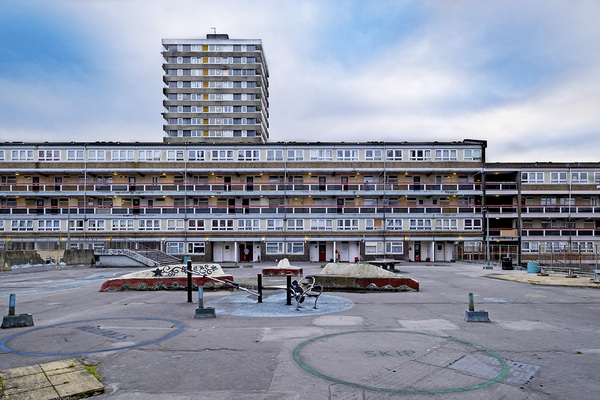You are viewing 1 of your 1 free articles
 Jules Birch
Jules BirchHousing insecurity takes centre stage
Jules Birch casts his eye over two reports this week shining a spotlight on evictions and temporary accommodation
 Jules Birch
Jules BirchTwo reports over the weekend put housing insecurity firmly under the spotlight.
On Saturday the Local Government Association (LGA) made all the headlines when it highlighted the 120,000 children currently in temporary accommodation.
That’s not a new figure (it comes from homelessness statistics published a month ago) but that does not make it any less shocking. And the LGA puts it into real perspective by pointing out that the increase since 2014 is the equivalent of one secondary school full of children every month.
On Sunday, the Joseph Rowntree Foundation (JRF) published research looking at where much of that demand for temporary accommodation is coming from: evictions and forced moves from rented homes.
The report found that 40,000 tenants were evicted from their homes by landlords in 2015 and that private landlords are now carrying out more evictions than councils and housing associations.
That may not be much of a claim to fame for ‘social’ landlords, but the rise in evictions reflects both the growth of the private rented sector and increasing use of Section 21 ‘no fault’ evictions by private landlords.
“The shortage of social housing has also led to the rise of what almost amount to parallel ‘social’ sectors.”
The research also uncovered worrying evidence of many more forced moves as tenants faced problems with affordability and housing conditions or had disputes with landlords and were forced out without any formal legal notice.
The two reports are of course analysing two sides of the same problem since the fastest growing reason why families become homeless is the loss of an assured shorthold tenancy (AST) in the private rented sector.
Meanwhile cuts in housing benefit make private landlords more reluctant to let to tenants who are claiming it.
The LGA points out that homelessness prevention by local authorities into the private rented sector has dropped by 40% since 2009.
All this at the same time as an endemic shortage of social housing forces more tenants to look to the private sector.
Both reports highlight the impact of the benefit cap and the benefit freeze as Local Housing Allowance (LHA) rates fall further and further behind actual rents, as well as the likely future impact of Universal Credit and the LHA cap.
For me they also reveal that the shortage of social housing has also led to the rise of what almost amount to parallel ‘social’ sectors: the bottom end of the private rented sector, with poor conditions and little choice; a temporary accommodation sector with properties owned by or leased from private landlords but also owned and run by social landlords; and a growing number of ASTs developed or acquired by local authorities to discharge their homelessness duty.
However, they are also looking at two different problems. For the LGA, the priority is to find ways for councils to carry out their duty to homeless families while controlling net costs that have tripled for councils in the last three years.
That could mean avoiding the most expensive forms of temporary accommodation (Brent Council estimates that it loses an average of £178 a week for each family in B&B) and finding ways to innovate in new supply such as modular housing and to finance the acquisition of new stock.
But it also forces councils into decisions that seem contradictory and maybe even counter-productive: making greater use of Localism Act powers to end a homelessness duty in the private rented sector may tackle the problem in the short term but won’t that just mean more ASTs and more Section 21s in future?
Some councils feel forced to pay extra to private landlords to persuade them to accept homeless families but the JRF report recommends that such sweeteners should only be used in cases where there is a long-term plan for how the tenant will afford the rent or for long-term tenancies of five or more years.
“The evictions figures are just one part of a bigger problem.”
The report finds “clear evidence that the increasing eviction rates are linked to the overall growth of the PRS and to cuts in LHA”.
Use of Section 21 evictions is geographically concentrated, with two-thirds of them happening in London and a third in just five boroughs: Newham, Enfield, Haringey, Brent and Croydon.
Rising rents and growing shortfalls against housing benefit are obvious reasons but the report says other possible reasons include growing competition from short-term letting websites and growing use of private renting by councils in situations where the tenant cannot afford the rent.
Meanwhile the evictions figures are just one part of a bigger problem that also includes forced moves and landlord intimidation. Some tenants said their landlords simply turned up and changed the locks while they were out.
Others felt forced to stay living in poor and sometimes unsafe conditions because they could not afford anything else.
Both reports make a series of practical recommendations for government, landlords and local authorities. However, in the end you get the sense that something has to give.
“Further changes will surely have to be made to improve security in the private rented sector.”
For all the good intentions behind the Homelessness Reduction Act, especially for people who fall outside the statutory homelessness system, benefit cuts that amount to homelessness expansion policies will continue to exacerbate the problem.
And all this is before the full impact of Universal Credit is felt, with delays and changes to the way housing costs are paid, lower payments than under tax credits, the risks of losing transitional protection and the impact of in-work conditionality.
Only a minority of areas currently have full service Universal Credit but one early adopter I spoke to recently was so worried about the financial impacts of increased homelessness that it was considering a ‘no eviction’ policy for social housing.
Further changes will surely have to be made to improve security in the private rented sector. The government in England has acted to stop retaliatory evictions and to ban letting agent fees (though only a draft bill was promised in the Queen’s Speech) and Labour is committed to longer tenancies.
Will England eventually follow Scotland’s example by introducing new tenancies that cannot be ended on ‘no fault’ grounds but only in specified circumstances such as where the landlords needs to sell or move into the property.
The experience of similar legislation in Ireland suggests that landlords will be able to find ways round this if they choose but it still sounds like a step forward under a system that generates evictions and homelessness.
If only somebody could come up with an alternative that gave tenants more security at rents that are affordable on low incomes and on housing benefit, and that saved the government money in the longer term.
Jules Birch, editor, Welsh Housing Quarterly









